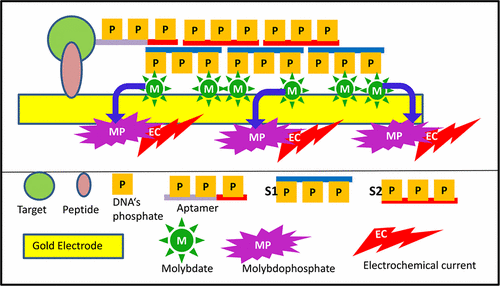当前位置:
X-MOL 学术
›
Anal. Chem.
›
论文详情
Our official English website, www.x-mol.net, welcomes your
feedback! (Note: you will need to create a separate account there.)
Self-Assembled DNA Generated Electric Current Biosensor for HER2 Analysis
Analytical Chemistry ( IF 6.7 ) Pub Date : 2017-09-13 00:00:00 , DOI: 10.1021/acs.analchem.7b01747 Congcong Shen 1 , Ke Zeng 1 , Junjun Luo 1 , Xiaoqing Li 1 , Minghui Yang 1 , Avraham Rasooly 2
Analytical Chemistry ( IF 6.7 ) Pub Date : 2017-09-13 00:00:00 , DOI: 10.1021/acs.analchem.7b01747 Congcong Shen 1 , Ke Zeng 1 , Junjun Luo 1 , Xiaoqing Li 1 , Minghui Yang 1 , Avraham Rasooly 2
Affiliation

|
We have developed a new DNA self-assembly amplification technology that generates electric current for electrochemical biosensing. The new technology was used for detection of human epidermal growth factor receptor 2 (HER2). In our technology, an aptamer was utilized both as a ligand for recognition and as a signal generating reporter. The aptasensor is based on a sandwich format and a DNA primer on a HER2 aptamer initiates auxiliary DNA self-assembled on the electrode to form a long one-dimensional DNA. The resulting DNA is then reacted with molybdate to generate electrochemical current. The sensitivity of the aptasensor with DNA self-assembly was greater than that of the aptasensor without DNA self-assembly due to the extended length of the DNA strand. Aptasensor analysis of HER2 in serum of breast cancer patients and healthy individuals is highly correlated (R2 = 0.9924) with ELISA measurements, with a p value of 1.37 × 10–7. The analysis of HER2 in serum (confirmed by ELISA) suggests that HER2 levels in breast cancer patients are much higher than healthy individuals. For HER2 positive patients, the levels are higher than those of HER2 negative patients. After surgery, there is a drop of HER2 levels in serum, suggesting potential clinical applications of the new self-assembled DNA electric current generating biosensor. Unlike proteins, DNA is easily amplifiable. The DNA signal amplification method presented here enables effective current generation, which can find wide range of biomedical applications for protein detection.
中文翻译:

自组装DNA产生的电流生物传感器用于HER2分析
我们已经开发了一种新的DNA自组装扩增技术,该技术可产生用于电化学生物传感的电流。这项新技术用于检测人类表皮生长因子受体2(HER2)。在我们的技术中,适体既用作识别的配体,又用作产生信号的报告基因。适体传感器基于三明治格式,HER2适体上的DNA引物引发在电极上自组装的辅助DNA,形成长的一维DNA。然后使所得的DNA与钼酸盐反应以产生电化学电流。由于DNA链的长度增加,具有DNA自组装的适体传感器的灵敏度要高于没有DNA自组装的适体传感器的灵敏度。R 2 = 0.9924),采用ELISA测量,p值为1.37×10 –7。血清中HER2的分析(通过ELISA证实)表明,乳腺癌患者中HER2的水平比健康个体高得多。对于HER2阳性患者,其水平高于HER2阴性患者。手术后,血清中HER2水平下降,表明这种新型自组装DNA电流产生生物传感器的潜在临床应用。与蛋白质不同,DNA易于扩增。此处介绍的DNA信号放大方法可实现有效的电流产生,可发现广泛的生物医学应用来检测蛋白质。
更新日期:2017-09-13
中文翻译:

自组装DNA产生的电流生物传感器用于HER2分析
我们已经开发了一种新的DNA自组装扩增技术,该技术可产生用于电化学生物传感的电流。这项新技术用于检测人类表皮生长因子受体2(HER2)。在我们的技术中,适体既用作识别的配体,又用作产生信号的报告基因。适体传感器基于三明治格式,HER2适体上的DNA引物引发在电极上自组装的辅助DNA,形成长的一维DNA。然后使所得的DNA与钼酸盐反应以产生电化学电流。由于DNA链的长度增加,具有DNA自组装的适体传感器的灵敏度要高于没有DNA自组装的适体传感器的灵敏度。R 2 = 0.9924),采用ELISA测量,p值为1.37×10 –7。血清中HER2的分析(通过ELISA证实)表明,乳腺癌患者中HER2的水平比健康个体高得多。对于HER2阳性患者,其水平高于HER2阴性患者。手术后,血清中HER2水平下降,表明这种新型自组装DNA电流产生生物传感器的潜在临床应用。与蛋白质不同,DNA易于扩增。此处介绍的DNA信号放大方法可实现有效的电流产生,可发现广泛的生物医学应用来检测蛋白质。











































 京公网安备 11010802027423号
京公网安备 11010802027423号